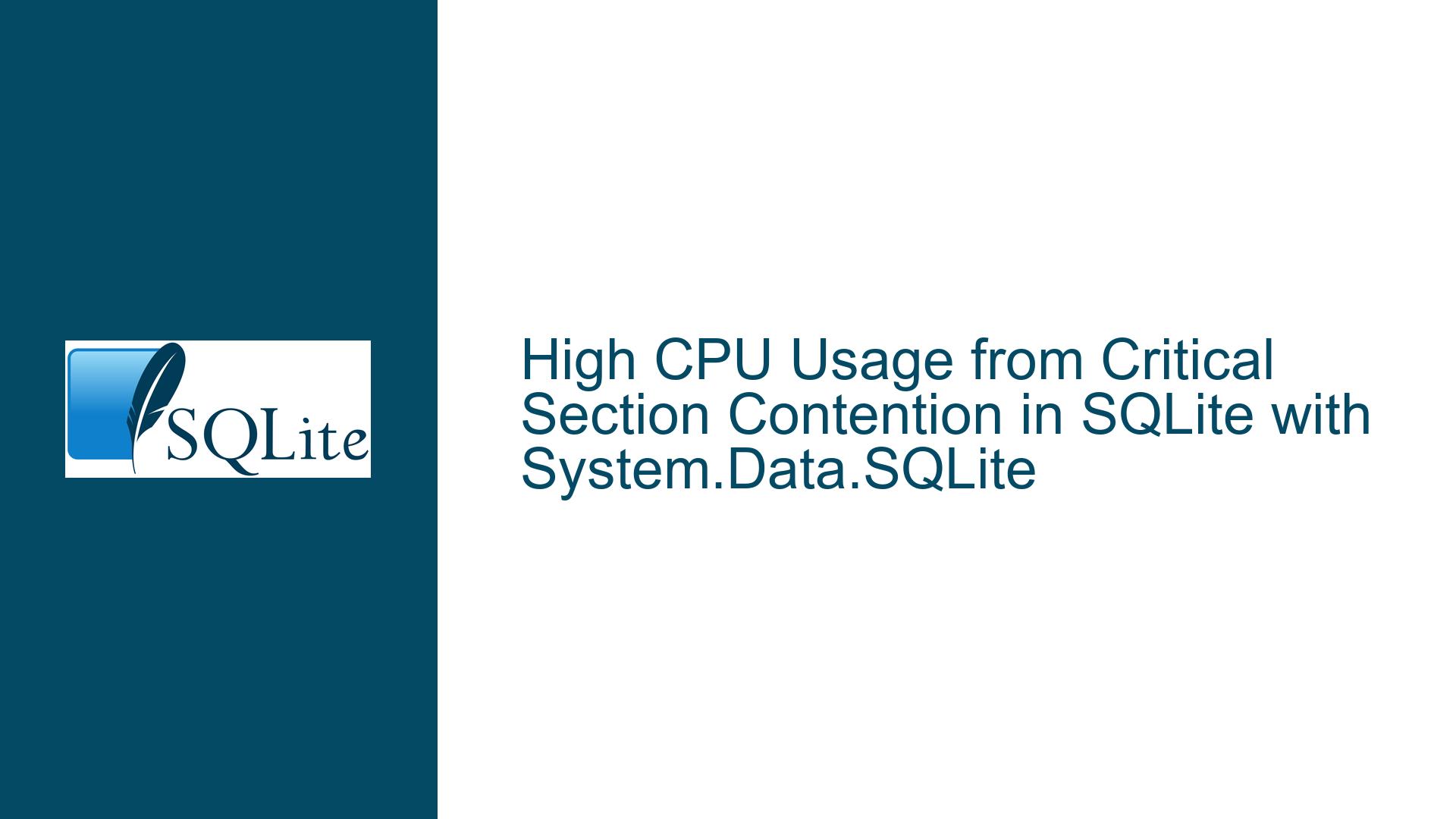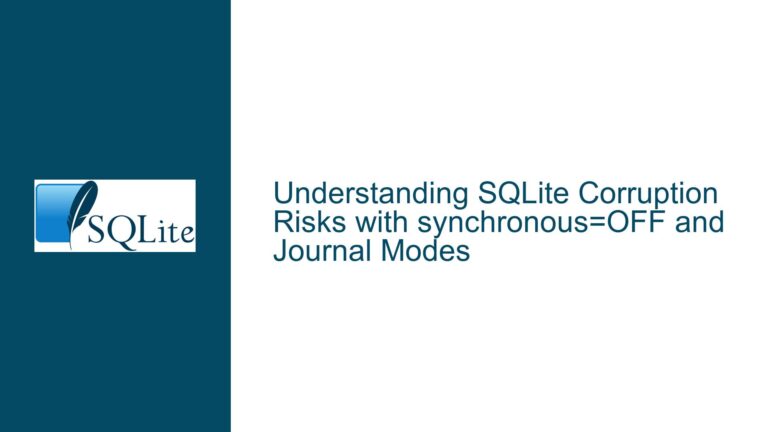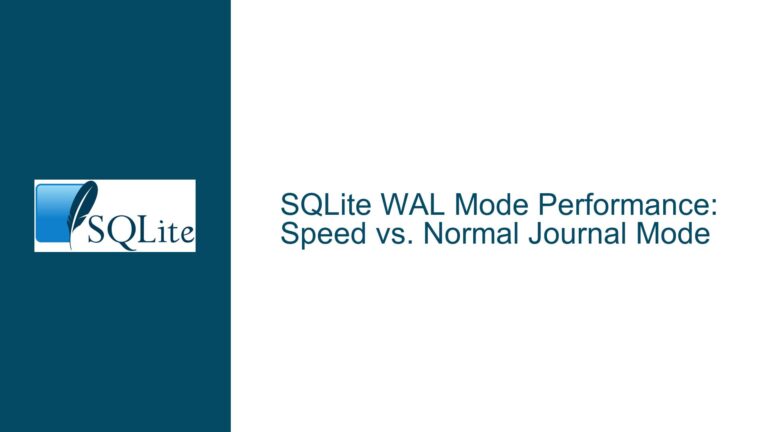High CPU Usage from Critical Section Contention in SQLite with System.Data.SQLite
Understanding Critical Section Contention in SQLite Under Concurrent Workloads
Root Cause Analysis of RtlpEnterCriticalSectionContended in SQLite Operations
The core issue revolves around excessive CPU utilization traced to RtlpEnterCriticalSectionContended during SQLite operations, particularly in the Prepare and Dispose phases of command execution. This Windows API function manages thread synchronization via critical sections, which are lightweight mutexes guarding shared resources. In SQLite, critical sections are used internally to coordinate access to database connections, prepared statements, and other shared structures. When threads contend for these resources, they enter a spin-wait loop, consuming CPU cycles until the critical section is released. The observed 30% CPU increase stems from thread contention exacerbated by high concurrency, suboptimal connection/command lifecycle management, or misconfigured SQLite pragmas. Key factors include:
SQLite’s Locking Architecture:
SQLite employs a granular locking hierarchy to enforce ACID guarantees. Even in Write-Ahead Logging (WAL) mode, which reduces contention between readers and writers, internal locks protect shared data structures like thesqlite3database handle, prepared statements, and the page cache. The .NET providerSystem.Data.SQLitewraps these mechanisms with additional critical sections to ensure thread safety, leading to contention when multiple threads execute commands concurrently.Connection and Command Lifecycle Overhead:
The call stacks indicate contention duringSQLiteCommand.BuildNextCommand()(statement preparation) andSQLiteCommand.Dispose()(statement finalization). EachPrepareoperation parses SQL, generates bytecode, and acquires locks on the database handle. Similarly,Disposereleases statement resources and cleans up connections. Frequent creation/disposal of commands without reuse amplifies contention.Thread Pool Saturation and Connection Pooling:
The application’s thread pool configuration and SQLite connection pool settings (e.g.,Max Pool Size=256) influence contention. If the pool size exceeds the physical/core thread count, oversubscription occurs, forcing threads to compete for CPU time and database resources. Threads blocked on critical sections contribute to CPU load as the OS scheduler cycles through them.P/Invoke and Marshaling Overhead:
Thesqlite.interoplayer (a native SQLite library) interacts with managed code via Platform Invocation Services (P/Invoke). Each call across this boundary incurs marshaling costs and transient locks. RepeatedPrepare/Finalizecycles exacerbate this overhead, especially with non-parameterized queries requiring frequent SQL parsing.
Diagnosing Critical Section Contention in SQLite-Based Applications
Identifying Concurrency Bottlenecks and Configuration Misalignments
Threading Model and Concurrency Patterns:
Applications transitioning from in-memory data structures to SQLite often retain a parallel execution model optimized for lock-free access. SQLite’s threading mode (SERIALIZEDby default) requires serialized access to database handles, conflicting with highly parallel workloads. For instance, a thread-per-request web app issuing concurrent read/write commands will encounter contention at the database handle level.Suboptimal Prepared Statement Management:
TheBuildNextCommandstack trace suggests ad-hoc SQL generation without parameterization. Non-reusable commands force SQLite to reparse identical queries, increasing time spent insqlite3_prepare_v2(guarded by critical sections). Similarly, improper disposal (e.g., not reusingSQLiteCommandinstances) triggers frequentsqlite3_finalizecalls, which acquire locks to free statement resources.WAL Mode Trade-offs:
While WAL improves concurrency by allowing simultaneous readers and a single writer, it introduces contention for the WAL-index shared memory region. High write rates combined with long-running readers can stall writers, increasing contention. The default WAL autocheckpoint settings may also trigger unintended I/O during busy periods.Synchronous and Journaling Settings:
PRAGMAs likesynchronous=NORMALorFULLenforce flushing guarantees but introduce synchronization points. Each flush acquires locks on the WAL file or database header, contributing to contention. Similarly, a misconfiguredcache_size(too small) forces frequent page evictions, requiring locks to update the cache.Garbage Collection Pressure:
TheSQLiteCommand.Disposestack traversesCriticalHandle.Cleanup, indicating reliance on finalizers for resource release. Finalization delays prolong the lifetime of native statement handles, causing intermittent contention spikes when the garbage collector runs.
Mitigating Critical Section Contention: Configuration, Code, and Monitoring Strategies
Optimizing SQLite and Application Code for High-Concurrency Scenarios
1. Connection and Command Pooling Tuning
- Reduce Connection Pool Contention:
Lower theMax Pool Sizeto match the application’s peak concurrency (e.g., physical core count). Oversized pools encourage thread oversubscription. UsePooling=Falsefor single-threaded scenarios. - Reuse Commands and Connections:
Implement aSQLiteCommandcache usingSystem.Collections.Concurrent.ConcurrentBagor a custom pool. Reuse parameterized commands to avoid re-parsing SQL:var command = connection.CreateCommand(); command.CommandText = "SELECT * FROM table WHERE id = @id"; command.Parameters.Add("@id", DbType.Int32); // Reuse 'command' across requests, resetting parameters as needed - Ensure Timely Connection Disposal:
Avoid holding connections open longer than necessary. Useusingblocks or dependency injection with scoped lifetimes (in web apps) to enforce deterministic disposal.
2. SQLite PRAGMA Configuration
- Adjust Synchronous and Journaling Modes:
SetPRAGMA synchronous=OFFfor workloads prioritizing performance over crash resilience. Combine withPRAGMA journal_mode=MEMORYto store rollback journals in RAM (volatile but faster). - Increase Cache Size:
PRAGMA cache_size=-10000(10,000 pages, ~40MB) reduces page evictions and associated locks. Monitorpage_cache_hit/page_cache_missinsqlite3_status()to fine-tune. - Disable Locking (For Read-Only or Single-Threaded Workloads):
PRAGMA locking_mode=EXCLUSIVEholds a write lock permanently, eliminating contention. Suitable for single-writer scenarios.
3. Concurrency Control and Threading
- Limit Concurrent Writers:
Use a scheduler or semaphore to throttle write operations. For example, employ aSystem.Threading.SemaphoreSlimto allow only one writer at a time while permitting concurrent reads. - Offload I/O to Dedicated Threads:
Execute SQLite operations on dedicated long-running threads (viaTask.Runor aThreadPoolwithSetMinThreads) to reduce context switching and contention.
4. Prepared Statement Optimization
- Parameterize All Queries:
Replace inline values with parameters to enable statement reuse:// Bad: Ad-hoc query with inline value command.CommandText = $"SELECT * FROM users WHERE name = '{name}'"; // Good: Parameterized query command.CommandText = "SELECT * FROM users WHERE name = @name"; command.Parameters.AddWithValue("@name", name); - Precompile Frequently Used Statements:
UseSQLiteConnection.GetCachedStatement(if available in your provider) or a static cache to retainSQLiteCommandinstances across requests.
5. Profiling and Monitoring
- Enable SQLite’s Internal Profiling:
Usesqlite3_profile(via P/Invoke) to log query execution times and lock acquisition patterns. Identify long-running queries contributing to contention. - Analyze Lock Wait Times:
Querysqlite3_lockedandsqlite3_busystatus counters to quantify contention. High values indicate lock hierarchy bottlenecks. - Inspect Thread Pool Metrics:
MonitorThreadPool.GetAvailableThreads()andThreadPool.GetMaxThreads()to detect thread starvation. AdjustSetMinThreadsto reduce cold-start delays.
6. Alternative Providers and Native Optimization
- Migrate to Microsoft.Data.Sqlite:
Test withMicrosoft.Data.Sqlite(supports .NET Core’s async model) to evaluate if it reduces P/Invoke overhead. It usesSQLitePCL.rawwith configurable native library loading. - Link Against a Custom SQLite Build:
Compile SQLite with-DSQLITE_THREADSAFE=2(multi-threaded mode) and-DSQLITE_DEFAULT_WAL_SYNCHRONOUS=1to tailor locking behavior. Disable unused features (-DSQLITE_OMIT_PROGRESS_CALLBACK) to minimize native code paths.
7. Application-Level Caching and Batching
- Introduce a Read Cache:
UseMemoryCacheor a dictionary to cache query results, reducing read frequency. Invalidate cached entries on writes via triggers or manual expiration. - Batch Writes:
Aggregate multiple INSERT/UPDATE operations into transactions. Batch sizes of 100-1,000 rows balance lock duration and memory usage:using (var transaction = connection.BeginTransaction()) { foreach (var item in items) { command.Parameters["@id"].Value = item.Id; command.ExecuteNonQuery(); } transaction.Commit(); }
By systematically addressing connection management, query parameterization, PRAGMA settings, and concurrency patterns, developers can mitigate critical section contention in SQLite. The 30% CPU overhead is not an inherent cost of ACID compliance but a signal to optimize threading and resource lifecycle strategies. Continuous profiling and incremental tuning are essential to balance performance with SQLite’s durability guarantees.






